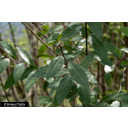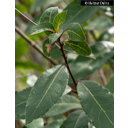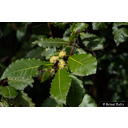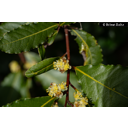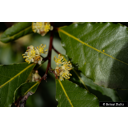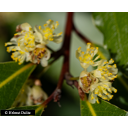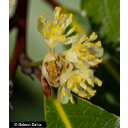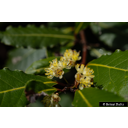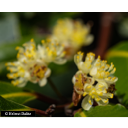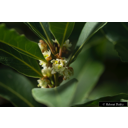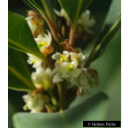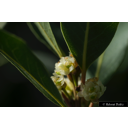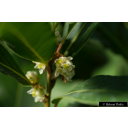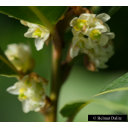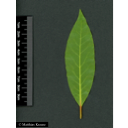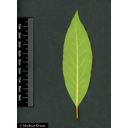Useful information about the taxon (species, subspecies, variety...)
Laurus nobilis L. 1753
Lauraceae
- Laurel family (APG IV)bay laurel, laurel, sweet bay, Grecian laurel, Mediterranean laurel, true laurel
Taxon concept: The Plant List (2010)
Distribution: Europe: Iberian Peninsula, France and Benelux, Corsica, Apennine Peninsula, Balkan Peninsula; Turkey, Caucasian states; Israel, Syria, North Africa; introduced to the Crimean Peninsula
Laurus nobilis L. - Accepted: Laurus nobilis L. bei Zander 2008; Familie: Lauraceae (Zander 2008)Laurus nobilis L. - Accepted: Laurus nobilis L. bei The Plant List (2010); Familie: Lauraceae (APG III)Laurus nobilis L. - Accepted: Laurus nobilis L. bei The Plant List (2014), version 1.1; Familie: Lauraceae (APG III)Laurus nobilis L. - Accepted: Laurus nobilis L. bei The Plant List (2014), version 1.1; Familie: Lauraceae (APG IV)Laurus nobilis L. - Accepted: Laurus nobilis L. bei World Flora Online; Familie: Lauraceae (APG IV)
- Color of flower
- pale yellow
- Flowers
- dioecious
- Flower ecology
- insect-pollinated (entomophilous) (bees)
- Life form
- shrub or small tree
- Leaves
- coriaceous leaves
- Foliage persistence
- evergreen
- Fruits
- fruit is a black drupe
- Fruit ecology
- bird-dispersed (ornithochorous)
- Soil conditions
- preferentially on moist limestone soils
- Root type
- shallow root system
- Natural occurrence (habitat)
- woodlands, scrub, sea cliffs, dunes, coastal shrubland, humid canyons and valleys, river banks, road sides, relict laurel forests ("Laurus nobilis thickets")
- Comment to ecology
- relict species of the laurel forests
- Vegetation typ and synecology (plant community)
- Mediterranean, broad-leaved evergreen, sclerophyllous forests, woodlands and shrubs
- Constraints according moisture
- drought tolerant
- Usage
- as spice plant; as medicinal plant: astringent, appetising, carminative, digestive and diuretic properties, used against respiratory afflictions; laurel oil obtained from the fruits (Oleum Lauri) can be used in the treatment of sprains and rheumatism, and as an insect repellent due to the lauric acid content; used in perfumery; as ornamental plant
Botanical Society of the British Isles and the Biological Records Centre (2012): Online Atlas of the British and Irish Flora. See: http://www.brc.ac.uk/plantatlas/; Erhardt, W., Götz, E., Bödeker, N. & Seybold, S. (2008): Der große Zander. Enzyklopädie der Pflanzennamen. Band 2. Arten und Sorten. Eugen Ulmer KG, Stuttgart (Hohenheim), 18. Aufl., 2103 S.; Frenzel, B. (2006): Heilpflanzen der Äbtissin Hildegrad von Bingen (1098 - 1179 n. Chr. im Botanischen Garten der Universität Hohenheim - ein Beispiel für den langen Gang medizinischer Erfahrungen und Hoffnungen. Hildegard von Bingen - und der Hohenheimer Heilpflanzengarten (Hrsg. Fellmeth, U.); Schönfelder, P. (2011): Das neue Handbuch der Heilpflanzen.. Franckh-Kosmos Verlags-GmbH & Co. KG, Stuttgart: 502. 978-3-440-12932-6.; The International Plant Names Index (2009). Published on the Internet http://www.ipni.org; Courtesy to IPNI, 2009. Exported from IPNI at date: 2009-09-22 20:17:51;
| Sex | Standort | Accession number | Planting year | Donation | IPEN | Lat. | Long. |
|---|---|---|---|---|---|---|---|
| Erkrankungen der Atemwege | HvB-15638 | XX-0-HOH-HvB-15638 | 48,70900878 | 9,21208514 | |||
| Gelenkserkrankungen | HvB-15638 | XX-0-HOH-HvB-15638 | 48,70891228 | 9,21204207 | |||
| Kübelpflanze | SYS-K-3771 | XX-0-HOH-SYS-K-3771 | 48,708498 | 9,210245 |

